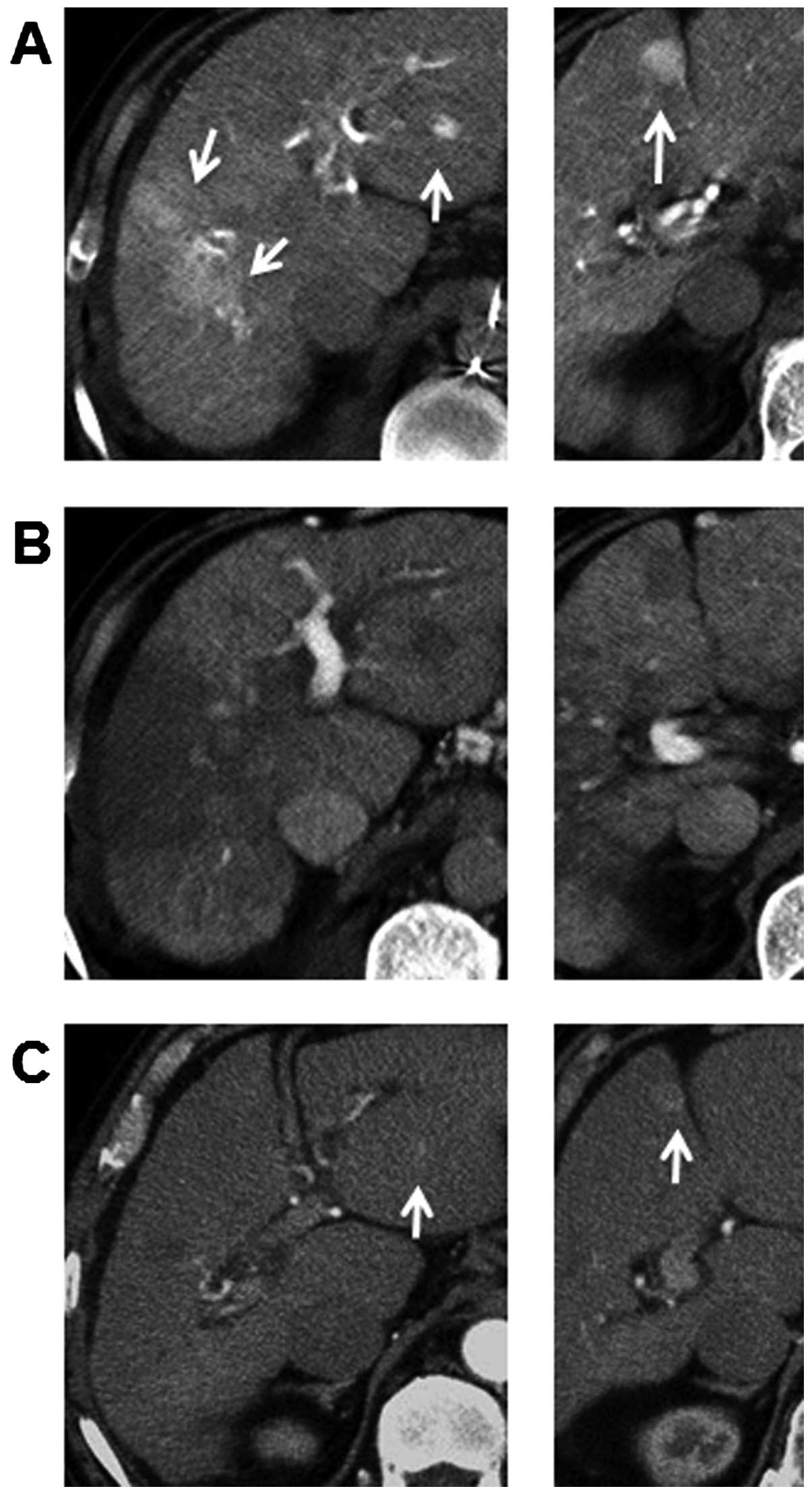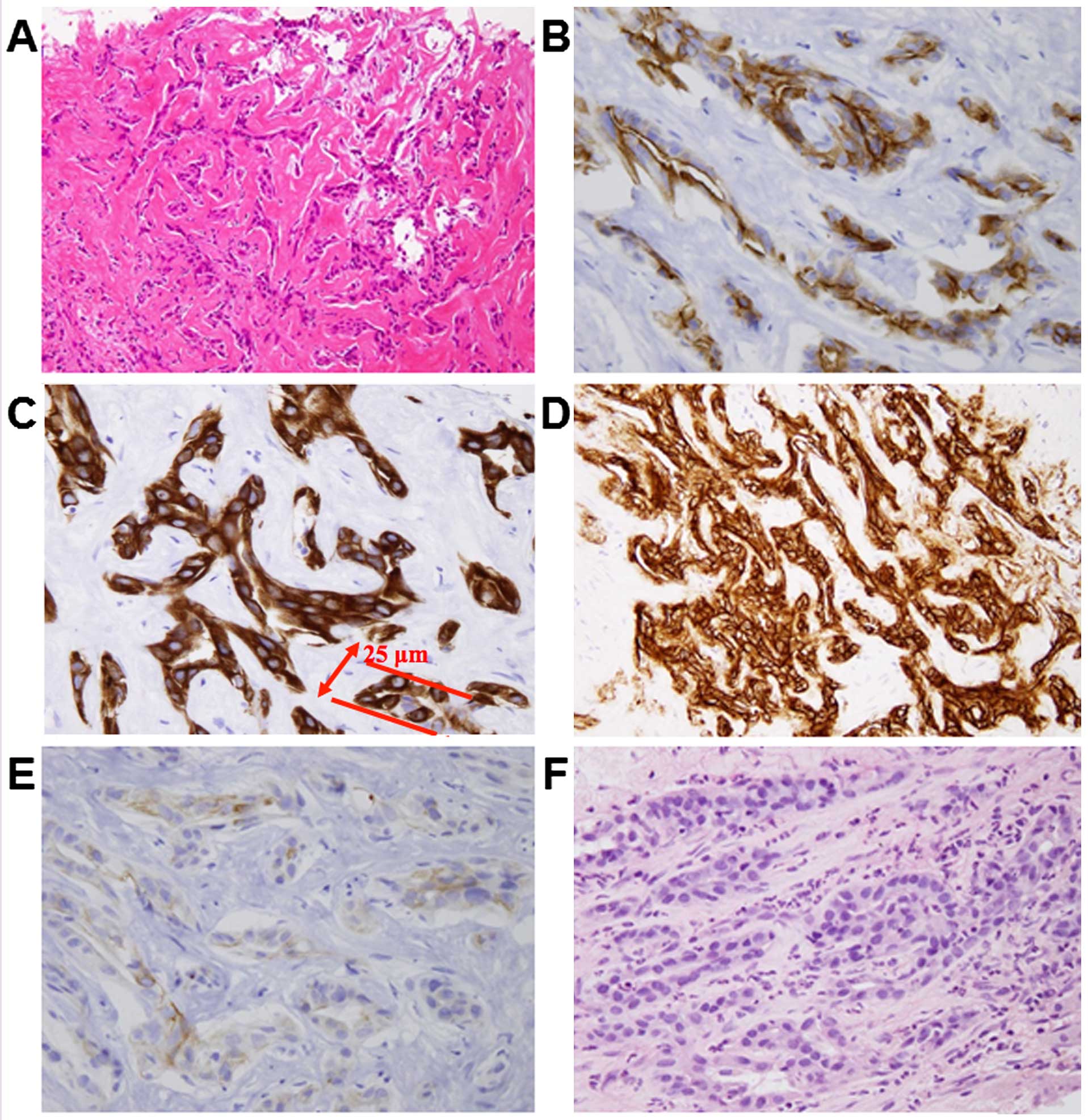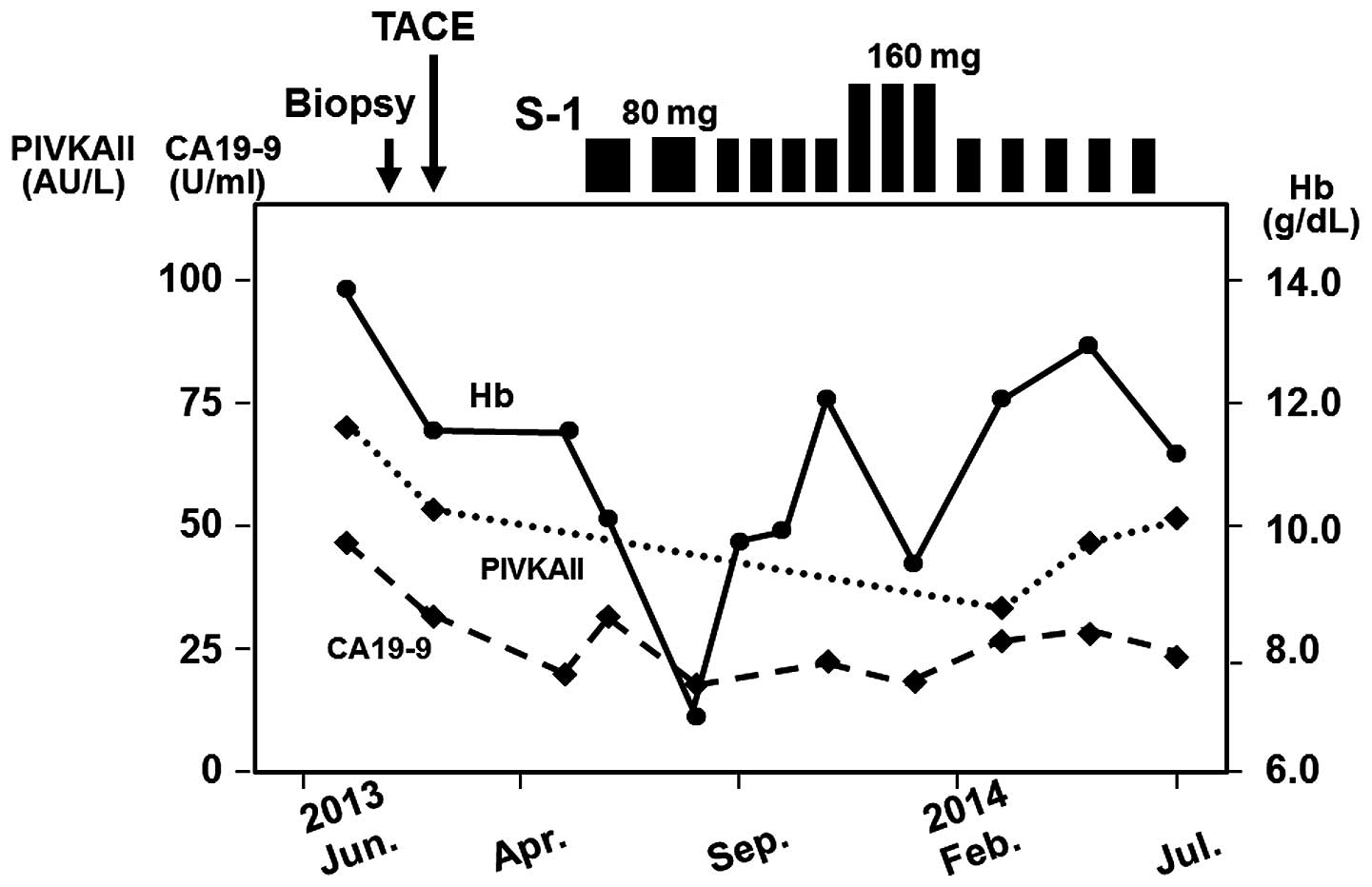S-1 monotherapy in a patient with cholangiolocellular carcinoma: A case report
- Authors:
- Published online on: October 11, 2016 https://doi.org/10.3892/mco.2016.1049
- Pages: 762-766
Abstract
Introduction
Cholangiolocellular carcinoma (CoCC) was first reported as an adenocarcinoma originating from the smallest cholangioles and ductules/Canals of Hering (1). CoCC is categorized as a subtype of intrahepatic cholangiocarcinoma (ICC) based on the criteria of the World Health Organization (WHO) (2). However, it is currently classified as a subtype of combined hepatocellular carcinoma (HCC) and cholangiocarcinoma (cholangiocellular subtype with stem cell characteristics), based on the criteria of the 2010 WHO classification (3). In Japan, CoCC was classified as an independent primary liver cancer in 2008 (4). In a Japanese study, four cases of CoCC were identified among 708 (0.56%) consecutively resected cases of primary liver cancer (5).
Due to its low frequency, the clinicopathological characterisitcs of CoCC have not yet been fully elucidated. Moreover, only few cases have been reported in the English literature. Surgery is the only curative treatment for CoCC. Ariizumi et al reported that hepatectomy in patients with CoCC produced favorable long-term survival rates due to the less invasive histopathological characteristics of this tumor (6). However, several cases may be discovered at an advanced stage; thus, chemotherapy is indispensable for the treatment of advanced CoCC. S-1 is an orally administered drug that combines three pharmacological agents: Tegafur (FT), a prodrug of 5-fluorouracil; 5-chloro-2,4-dihydroxypyridine (CDHP), which inhibits dihydroxypyridine dehydrogenase (DPD) activity; and potassium oxonate (Oxo), which reduces gastrointestinal toxicity (7). In a phase II trial for biliary tract cancer (BTC), including ICC, S-1 monotherapy showed promising results, with a favorable response rate (35%) and median survival time (9.4 months), with mild toxicity (8). Therefore, S-1 is considered to be a promising agent for the treatment of advanced BTC, and has been approved for advanced BTC by social insurance in Japan. S-1 has also been demonstrated to have potent antitumor activity against various solid tumors in clinical studies (9–12).
We herein present a case of CoCC diagnosed following liver biopsy and effectively treated by S-1 monotherapy.
Case report
A 71-year-old man was admitted to the Kansai Medical University Takii Hospital (Osaka, Japan) for investigation of hepatic lesions in a background of alcoholic cirrhosis, Child-Pugh class B (score 7). The hepatitis C virus antibody and hepatitis B surface antigen tests were negative. The levels of tumor markers, including carbohydrate antigen (CA) 19-9 and protein induced by vitamin K absence/antagonist-II (PIVKA-II) were marginally elevated (Table I). Ultrasound surveillance followed by a triple-phase computed tomography (CT) scan revealed various hypervascular lesions, measuring 54 mm in segment 5/8, 17 mm in segment 4 and 8 mm in segment 2. These tumors showed enhancement in the early phase of dynamic enhanced CT and persistent enhancement in the delayed phase. The margins of the tumors ware not clear. The patient also underwent hepatic angiography. On common hepatic angiography, the entire tumor showed hypervascularity and pooling on the delayed images. CT during hepatic arteriography (CTA) showed that the tumors were enhanced (Fig. 1A), whereas the tumors were depicted as a complete contrast defect using CT during arterial portography (CTAP) (Fig. 1B). Transarterial chemoembolization (TACE) was performed for these hypervascular lesions via the right and left hepatic arteries. A solution of lipiodol 5 ml, epirubicin 50 mg, and Gelfoam fine particles was injected. However, 1 week after TACE, a follow-up CT of the liver revealed the absence of almost any lipiodol granules.
Given the characteristic appearance of well-enhanced nodules with ill-defined margins, the differential diagnosis included CoCC, ICC, combined HCC and cholangiocarcinoma, focal nodular hyperplasia, or nodular transformation. An ultrasound-guided biopsy of the lesion at segment 5/8 was performed. The pathological findings revealed that the tumor cells exhibited mild atypia and invasively proliferated in a ductular morphology without mucinous fluid production. Immunohistochemical analysis for hepatocyte paraffin 1 was negative, whereas staining was positive for cytokeratin (CK) 7, CK19, epithelial cell adhesion molecule and epithelial membrane antigen (EMA); mucicarmine staining was negative (Fig. 2). The staining pattern for EMA showed positivity in the membranous area of the lumen; this membranous staining pattern of EMA is characteristic of CoCC (13). Thus, the tumor was histologically confirmed to be a CoCC.
The tumor was already at an advanced stage and surgical treatment was not possible due to insufficient function of the residual liver. In inoperable cases, palliative treatments are available, such as intra-arterial chemoembolization and systemic chemotherapy (14). The patient refused hospitalization and intra-arterial chemoembolization is only applied if systemic chemotherapy fails. The most promising approaches involve the use of single-agent gemcitabine or combination regimens with gemcitabine and cisplatin (15). However, the patient preferred systemic chemotherapy using only an oral administration agent. Thus, S-1 monotherapy was recommended.
S-1 was initially administered orally at a dose of 80 mg/day in May, 2013. The schedule was 4 weeks of S-1 administration followed by a 2-week drug-free interval. The clinical course following administration of S-1 is presented in Fig. 3. Although macrocytic anemia occurred after 2 cycles, the treatment was again implemented following an interruption. After a regimen of a 2-week treatment followed by 1-week rest was performed for 4 cycles, the dosage was increased to 160 mg/day. However, macrocytic anemia occurred again after 3 cycles; as a result, a regimen of 2 weeks of treatment at a dose of 80 mg/day followed by 2 weeks of rest has been used thereafter. Side effects other than hematological toxicity, such as skin pigmentation and diarrhea, were not observed for 15 months. Although tumor marker levels (PIVKAII and CA19-9) were marginally elevated, their values did not change over the entire course. Pleural effusion and ascites have not appeared during treatment. In addition, the tumor has not spread to lymph nodes or other organs. One year after S-1 monotherapy, a dynamic CT scan showed disappearance of the intratumoral arterial enhancement in the lesion at segment 5/8, whereas the lesions at segments 4 and 2 were both smaller in diameter (Fig. 1C).
Two standard sets of criteria were used to evaluate the tumor response to S-1 monotherapy: The Response Evaluation Criteria in Solid Tumors (RECIST) (16) and the modified RECIST (mRECIST) (17). According to RECIST, the sum of the longest diameters of all target lesions decreased by 53%, which was classified as partial response (PR) by the end of the 1-year treatment (Fig. 1C). According to mRECIST, the sum of the longest diameters of the enhanced tumor areas during the arterial phase decreased by 84%, which was also classified as PR (Fig. 1C).
Discussion
This case report describes a successful outcome using salvage chemotherapy with S-1 for unresectable CoCC in a patient resistant to prior TACE. As CoCC is an extremely rare primary malignant tumor in the liver, with a frequency as low as 0.56% in Japan (5), the optimal treatment option for unresectable CoCCs has not yet been determined.
The majority of CoCC cases exhibit hyperenhancement in the early phase of contrast-enhanced CT and hypervascularity on angiography (18,19). Persistent enhancement in the late phase of contrast-enhanced CT has often been confirmed. These characteristics may reflect slow diffusion of the contrast agent into the fibrotic component of the tumor, which is similarly seen in cases of ICC (20). The characteristics of this case were comparable to previous reports.
As CoCC is considered to be derived from the Canals of Hering (1), it has been suggested that CoCC is pluripotent and may develop into HCC and/or ICC (21). This case contained a CoCC component only according to histological analysis of the liver biopsy specimen. As a biopsy specimen was used, the histological findings may not reflect all the characteristics of the whole tumor and the other unexamined tumors. However, the imaging findings were uniform in each tumor and were similar among all tumors. In addition, the reduction of tumor size was relatively uniform during chemotherapy.
The origin of CoCC has been controversial since the first report by Steiner et al (1). CoCC was considered to be derived from the Canals of Hering. However, the interlobular ducts have also been hypothesized to be the origin of CoCC (1). According to the recent morphometric and immunohistochemical studies, CoCC closely resembles interlobular duct structure (22,23). In addition, the CoCC cases in those studies did not include HCC components. Although CoCCs were considered to be pluripotent and may develop into HCC and/or ICC (21), a considerable number of CoCCs are pure adenocarcinomas, without evidence of a HCC component. This fact may be the reason why the Liver Cancer Study Group of Japan does not recognize CoCC as combined HCC-cholangiocarcinoma (4). As the present case only contained a CoCC component and the imaging findings were uniform in each tumor and similar among all tumors, this case may be a CoCC of pure adenocarcinoma type. Based on the cancer duct size (25 µm), our case may originate from interlobular ducts. However, CoCC is categorized as a subtype of combined HCC-cholangiocarcinoma in the 2010 WHO classification (3). There are also CoCC cases with an HCC component. Kondo et al described a small CoCC component located in a large background area of HCC (23). It may also be hypothesized that only the CoCC component was biopsied from a combined HCC-cholangiocarcinoma. As a biopsy specimen was used, the histological findings may not reflect all the characteristics of the whole tumor and the other unexamined tumors.
To the best of our knowledge, there is only one report of correct diagnosis of CoCC using a needle biopsy tissue sample (24). The majority of reported cases of CoCC have been diagnosed using pathological findings from resected tumors (6,19,25). Therefore, if pathological diagnosis is not available due to advanced stage, CoCC may be clinically misdiagnosed as HCC due to the HCC-like early enhancement observed on dynamic CT. Chemotherapy for CoCC has not yet been reported. Further study is required regarding the response of CoCC to chemotherapy. Therefore, clinicians should consider the use of needle biopsy to ensure the correct diagnosis of atypical hypervascular lesions.
The prognosis of CoCC has not yet been clearly determined due to its low incidence. Motosugi et al reported that several-year follow-up studies indicate a quite varied doubling time of CoCC (26). Ariizumi et al reported that patients with CoCC exhibited less invasive histopathological characteristics with favorable long-term survival (6). However, the insufficient number of previously reported cases and the diversity of stage at diagnosis or postoperative treatment make it difficult to make any generalizations regarding clinical outcome. Further studies are required to elucidate the prognosis of CoCC.
In conclusion, S-1 monotherapy was generally well-tolerated and exhibited promising efficacy against advanced CoCC. Randomized controlled trials are required to establish effective treatment strategies for unresectable CoCC. However, it is difficult to recruit patients for trials, as CoCC is very rare. Multicenter trials are required to establish optimal treatments and improve the prognosis of patients with this disease.
References
|
Steiner PE and Higginson J: Cholangiolocellular carcinoma of the liver. Cancer. 12:753–759. 1959. View Article : Google Scholar : PubMed/NCBI | |
|
Hamilton SR and Aaltonen LA: Intrahepatic cholangiocarcinoma. In: World Health Organization Classification of TumorsPathology and Genetics of Tumours of the Digestive System. IARC Press; Lyon: 2000 | |
|
Theise ND, Nakashima O, Park YN and Nakanuma Y: Combined hepatocellular-cholangiocarcinomaWorld Health Organization Classification of Tumors. WHO classification of tumors of the digestive system. Bosman FT, Carneiro F, Hruban RH and Theise ND: IARC Press; Lyon: pp. 225–227. 2010 | |
|
Liver Cancer Study Group of Japan, . General rules for the clinical and pathological study of primary liver cancer. 5th. Revised version. Tokyo, Kanehara: pp. 462009 | |
|
Shiota K, Taguchi J, Nakashima O, Nakashima M and Kojiro M: Clinicopathologic study on cholangiolocellular carcinoma. Oncol Rep. 8:263–268. 2001.PubMed/NCBI | |
|
Ariizumi S, Kotera Y, Katagiri S, Nakano M, Nakanuma Y, Saito A and Yamamoto M: Long-term survival of patients with cholangiolocellular carcinoma after curative hepatectomy. Ann Surg Oncol. 21:(Suppl 3). S451–S458. 2014. View Article : Google Scholar : PubMed/NCBI | |
|
Miura K, Shirasaka T, Yamaue H and Sasaki I: S-1 as a core anticancer fluoropyrimidine agent. Expert Opin Drug Deliv. 9:273–286. 2012. View Article : Google Scholar : PubMed/NCBI | |
|
Furuse J, Okusaka T, Boku N, Ohkawa S, Sawaki A, Masumoto T and Funakoshi A: S-1 monotherapy as first-line treatment in patients with advanced biliary tract cancer: A multicenter phase II study. Cancer Chemother Pharmacol. 62:849–855. 2008. View Article : Google Scholar : PubMed/NCBI | |
|
Sakata Y, Ohtsu A, Horikoshi N, Sugimachi K, Mitachi Y and Taguchi T: Late phase II study of novel oral fluoropyrimidine anticancer drug S-1 (1 M tegafur-0.4 M gimestat-1 M otastat potassium) in advanced gastric cancer patients. Eur J Cancer. 34:1715–1720. 1998. View Article : Google Scholar : PubMed/NCBI | |
|
Ohtsu A, Baba H, Sakata Y, Mitachi Y, Horikoshi N, Sugimachi K and Taguchi T: Phase II study of S-1, a novel oral fluorophyrimidine derivative, in patients with metastatic colorectal carcinoma. S-1 Cooperative Colorectal Carcinoma Study Group. Br J Cancer. 83:141–145. 2000.PubMed/NCBI | |
|
Kawahara M, Furuse K, Segawa Y, Yoshimori K, Matsui K, Kudoh S, Hasegawa K and Niitani H: S-1 Cooperative Study Group (Lung Cancer Working Group): Phase II study of S-1, a novel oral fluorouracil, in advanced non-small-cell lung cancer. Br J Cancer. 85:939–943. 2001. View Article : Google Scholar : PubMed/NCBI | |
|
Saeki T, Takashima S, Sano M, Horikoshi N, Miura S, Shimizu S, Morimoto K, Kimura M and Taguchi T: A late phase II clinical study of S-1 in patients with progressed, refractory breast cancer. Cancer & chemotherapy. 31:539–547. 2004.(In Japanese). | |
|
Nakano M: Histopathological characteristic of cholangiolocellular carcinoma. J Biliary Tract Pancreas. 25:343–349. 2004. | |
|
Vogl TJ, Schwarz W, Eichler K, Hochmuth K, Hammerstingl R, Jacob U, Scheller A, Zangos S and Heller M: Hepatic intraarterial chemotherapy with gemcitabine in patients with unresectable cholangiocarcinomas and liver metastases of pancreatic cancer: A clinical study on maximum tolerable dose and treatment efficacy. J Cancer Res Clin Oncol. 132:745–755. 2006. View Article : Google Scholar : PubMed/NCBI | |
|
Park I, Lee JL, Ryu MH, Kim TW, Lee S Sook, Park D Hyun, Soo Lee S, Wan Seo D, Koo Lee S and Kim MH: Prognostic factors and predictive model in patients with advanced biliary tract adenocarcinoma receiving first-line palliative chemotherapy. Cancer. 115:4148–4155. 2009. View Article : Google Scholar : PubMed/NCBI | |
|
Therasse P, Arbuck SG, Eisenhauer EA, Wanders J, Kaplan RS, Rubinstein L, Verweij J, Van Glabbeke M, van Oosterom AT, Christian MC and Gwyther SG: New guidelines to evaluate the response to treatment in solid tumors. European Organization for Research and Treatment of Cancer, National Cancer Institute of the United States, National Cancer Institute of Canada. J Natl Cancer Inst. 92:205–216. 2000. View Article : Google Scholar : PubMed/NCBI | |
|
Lencioni R and Llovet JM: Modified RECIST (mRECIST) assessment for hepatocellular carcinoma. Semin Liver Dis. 30:52–60. 2010. View Article : Google Scholar : PubMed/NCBI | |
|
Matsuda M, Hara M, Suzuki T, Kono H and Fujii H: Synchronously resected double primary hepatic cancers - hepatocellular carcinoma and cholangiolocellular carcinoma. J Hepatobiliary Pancreat Surg. 13:571–576. 2006. View Article : Google Scholar : PubMed/NCBI | |
|
Kanamoto M, Yoshizumi T, Ikegami T, Imura S, Morine Y, Ikemoto T, Sano N and Shimada M: Cholangiolocellular carcinoma containing hepatocellular carcinoma and cholangiocellular carcinoma, extremely rare tumor of the liver: A case report. J Med Invest. 55:161–165. 2008. View Article : Google Scholar : PubMed/NCBI | |
|
Lacomis JM, Baron RL, Oliver JH III, Nalesnik MA and Federle MP: Cholangiocarcinoma: Delayed CT contrast enhancement patterns. Radiology. 203:98–104. 1997. View Article : Google Scholar : PubMed/NCBI | |
|
Komuta M, Spee B, Borght S Vander, De Vos R, Verslype C, Aerts R, Yano H, Suzuki T, Matsuda M, Fujii H, et al: Clinicopathological study on cholangiolocellular carcinoma suggesting hepatic progenitor cell origin. Hepatology. 47:1544–1556. 2008. View Article : Google Scholar : PubMed/NCBI | |
|
Maeno S, Kondo F, Sano K, Takada T and Asano T: Morphometric and immunohistochemical study of cholangiolocellular carcinoma: Comparison with non-neoplastic cholangiole, interlobular duct and septal duct. J Hepatobiliary Pancreat Sci. 19:289–296. 2012. View Article : Google Scholar : PubMed/NCBI | |
|
Kondo F and Fukusato T: Pathogenesis of cholangiolocellular carcinoma: Possibility of an interlobular duct origin. Intern Med. 54:1685–1694. 2015. View Article : Google Scholar : PubMed/NCBI | |
|
Joshita S, Ichijo T, Suzuki F, Yokoyama T, Sugiyama Y, Fukushima M, Kamijo A, Komatsu M, Umemura T, Yoshizawa K, et al: A case of well-differentiated cholangiolocellular carcinoma visualized with contrast-enhanced ultrasonography using Sonazoid. Hepatol Res. 39:207–212. 2009. View Article : Google Scholar : PubMed/NCBI | |
|
Maeda T, Hashimoto K, Ishida T, Yamashita Y, Saeki H, Kawanaka H, Uchiyama H, Ikeda T, Tsujitani S and Maehara Y: Repeat hepatectomy for intrahepatic recurrence of cholangiolocellular carcinoma. Fukuoka Acta Medica. 104:564–568. 2013. | |
|
Motosugi U, Ichikawa T, Nakajima H, Araki T, Matsuda M, Suzuki T, Fujii H, Nakazawa T and Yamaguchi H: Cholangiolocellular carcinoma of the liver: Imaging findings. J Comput Assist Tomogr. 33:682–688. 2009. View Article : Google Scholar : PubMed/NCBI |












